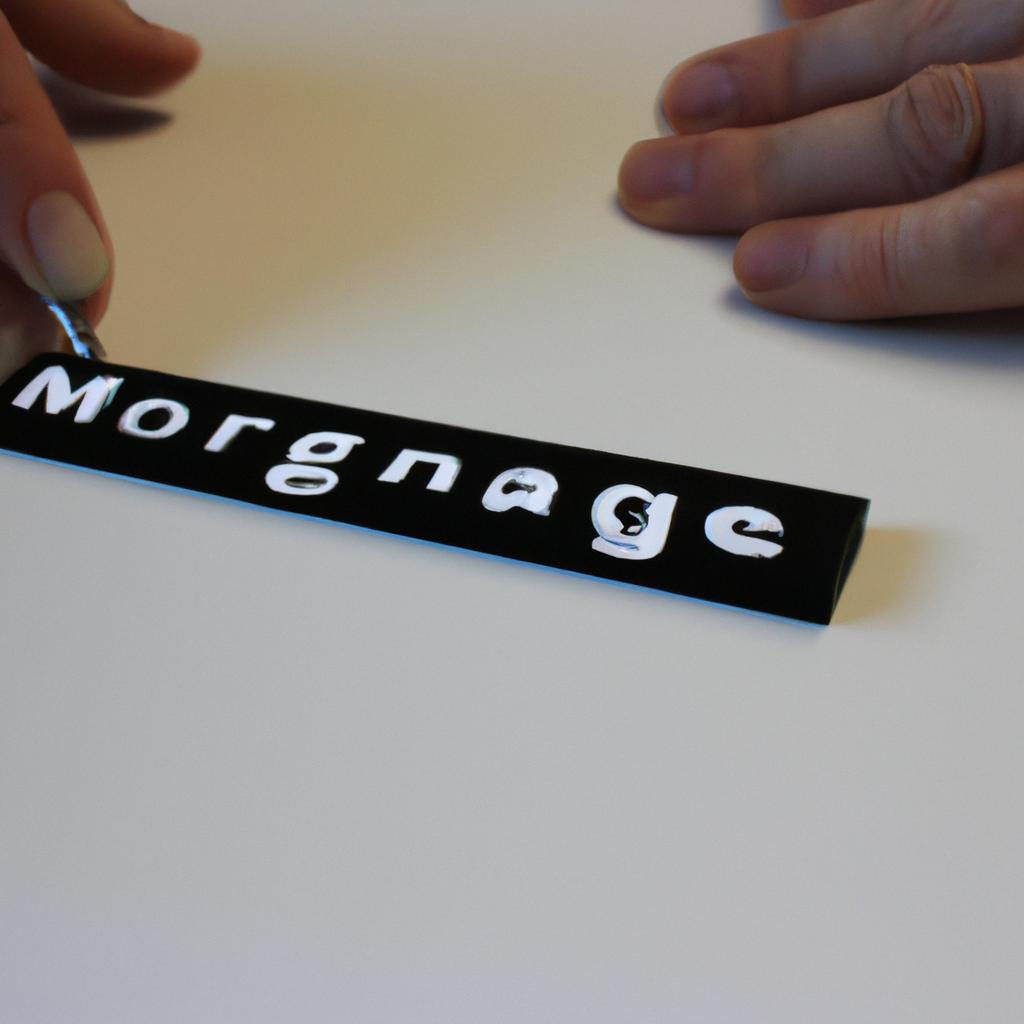The decision to refinance a mortgage is an important one that requires careful consideration of various factors. One key aspect to consider is whether to opt for a fixed-rate or adjustable-rate mortgage (ARM). A fixed-rate mortgage offers stability and predictable monthly payments, while an ARM provides flexibility with the potential for lower initial interest rates. To illustrate this comparison, let’s take the example of Mr. Johnson, who has recently decided to refinance his home loan.
Mr. Johnson currently holds a 30-year fixed-rate mortgage at an interest rate of 4%. However, he notices that market conditions have changed since he first took out his loan five years ago, and there may be opportunities to obtain a more favorable interest rate through refinancing. As he explores his options, Mr. Johnson finds himself torn between sticking with the reliability of a fixed-rate mortgage or taking advantage of potentially lower initial rates offered by an ARM. This article aims to provide an in-depth analysis comparing these two types of mortgages in the context of mortgage refinancing, enabling readers like Mr. Johnson to make informed decisions regarding their own financial situations.
Understanding Fixed-Rate Mortgages
One example that highlights the benefits of fixed-rate mortgages is the case of Sarah, a first-time homebuyer. Sarah was looking for stability and predictability in her mortgage payments, so she opted for a fixed-rate mortgage. This type of mortgage offers an interest rate that remains constant throughout the term of the loan, providing borrowers like Sarah with peace of mind knowing their monthly payment amount will not fluctuate.
To further understand the advantages of fixed-rate mortgages, let’s consider the following bullet points:
- Stability: With a fixed-rate mortgage, borrowers have the advantage of knowing exactly how much they need to pay each month. This allows for better budgeting and financial planning.
- Protection against rising interest rates: If interest rates increase over time, borrowers with fixed-rate mortgages are protected from these fluctuations. Their interest rate remains unchanged regardless of market conditions.
- Long-term affordability: Fixed-rate mortgages are ideal for individuals who plan on staying in their homes for an extended period since they offer consistent monthly payments over many years.
- Peace of mind: The knowledge that your monthly payment won’t unexpectedly rise can provide a sense of security and reduce financial stress.
| Characteristics | Advantages | Considerations |
|---|---|---|
| Stable | Predictable monthly payments | Higher initial interest rates may limit purchasing power |
| Long-term | Protection against rising interest rates | May not be suitable if planning to sell or refinance within a few years |
| No surprises | Easier budgeting and financial planning | Refinancing may incur additional costs |
As we explore adjustable-rate mortgages in the subsequent section, it is important to note that while fixed-rate mortgages offer stability and protection against changing market conditions, there are alternative options available to suit different financial goals and circumstances.
Exploring Adjustable-Rate Mortgages
Comparing Fixed-Rate and Adjustable-Rate Mortgages in Mortgage Refinancing
Imagine this scenario: Sarah, a homeowner looking to refinance her mortgage, is weighing the pros and cons of different options. She has come across two popular choices – fixed-rate mortgages (FRMs) and adjustable-rate mortgages (ARMs). Let us explore these alternatives further to understand their characteristics and determine which one may be more suitable for Sarah’s needs.
Fixed-rate mortgages offer stability and predictability in monthly payments over the life of the loan. Regardless of changes in market conditions or interest rates, the rate remains constant. This can be advantageous for homeowners seeking long-term financial planning without any surprises. Additionally, FRMs provide peace of mind by allowing borrowers to budget confidently while avoiding potential increases in payment amounts due to inflationary pressures.
On the other hand, adjustable-rate mortgages offer an initial fixed period with lower interest rates before transitioning into adjustable periods. During this initial phase, typically ranging from three to ten years, ARMs have lower introductory rates compared to FRMs. This feature can enable borrowers like Sarah to benefit from reduced monthly payments during the early years of homeownership or refinancing. However, after the initial fixed term expires, ARM loans are subject to fluctuations based on prevailing market conditions.
To better illustrate the differences between these two types of mortgages, consider the following emotional responses that might arise when contemplating each option:
- Peace of Mind: The certainty provided by a fixed-rate mortgage allows homeowners to plan their finances securely without worrying about unexpected changes.
- Flexibility: An adjustable-rate mortgage offers flexibility during its initial period with potentially lower interest rates and lower monthly payments.
- Uncertainty: With an adjustable-rate mortgage, there is always uncertainty regarding future interest rate adjustments once the fixed period ends.
- Risk Management: A fixed-rate mortgage helps mitigate risks associated with fluctuating interest rates and economic uncertainties.
Let us now delve deeper into comparing interest rates, examining how they differ between fixed-rate and adjustable-rate mortgages. This analysis will provide Sarah with valuable insights into the possible financial implications of each option, helping her make an informed decision that aligns with her goals and preferences.
Comparing Interest Rates
Exploring Adjustable-Rate Mortgages has provided us with a comprehensive understanding of this type of mortgage. Now, let’s delve into comparing interest rates between fixed-rate and adjustable-rate mortgages in the context of mortgage refinancing.
To illustrate the comparison, consider the following example: Mr. Smith currently holds an adjustable-rate mortgage (ARM) at 3% interest for five years, after which it will adjust annually based on market conditions. On the other hand, Mrs. Johnson has a fixed-rate mortgage (FRM) at 4%. Both individuals are considering refinancing their mortgages to take advantage of lower interest rates in the market.
When comparing interest rates between FRMs and ARMs, several factors come into play:
-
Initial Interest Rate:
- FRM: The initial interest rate remains constant throughout the loan term.
- ARM: The initial rate is typically lower than that of an FRM but subject to adjustment after a specified period.
-
Adjustment Periods:
- FRM: There are no adjustments as the interest rate remains unchanged.
- ARM: After the initial period, usually ranging from one to ten years, the interest rate adjusts periodically according to predetermined terms.
-
Market Risk:
- FRM: Borrowers have protection against rising interest rates since their rates remain fixed.
- ARM: Borrowers face potential exposure to fluctuating market rates when their adjustable periods begin.
-
Flexibility and Payment Stability:
- FRM: Offers stability and predictability as monthly payments stay consistent over time.
- ARM: Provides flexibility initially with potentially lower payments during low-interest periods but may result in higher payments when rates rise.
Let’s further visualize these differences through a table:
| Fixed-Rate Mortgage (FRM) | Adjustable-Rate Mortgage (ARM) | |
|---|---|---|
| Initial Interest Rate | Remains Constant | Typically Lower than FRM, subject to adjustment |
| Adjustment Periods | No adjustments | Adjustments after Initial Fixed Rate Period |
| Market Risk | Protected from Rise | Potential Exposure to Fluctuating Market Rates |
| Flexibility and Payment Stability | Consistent Payments over Time | Flexible initially with potential payment fluctuations |
Examining Payment Stability is the next step in our analysis. By understanding how monthly payments may change under different mortgage options, borrowers can make informed decisions regarding their refinancing choices.
Examining Payment Stability
Having compared the interest rates associated with fixed-rate and adjustable-rate mortgages, it is now essential to delve into another crucial aspect of mortgage refinancing – payment stability. By understanding how these two types of mortgages differ in terms of payment stability, borrowers can make a more informed decision when considering whether to refinance.
Payment stability is an important factor for homeowners as they seek to manage their finances effectively over the long term. To illustrate this point, let’s consider a hypothetical scenario involving two homeowners who are contemplating mortgage refinancing options. Homeowner A chooses a fixed-rate mortgage, while homeowner B opts for an adjustable-rate mortgage (ARM).
To further analyze the differences in payment stability between these two types of mortgages, we can explore several key aspects:
-
Predictable Monthly Payments: With a fixed-rate mortgage, borrowers enjoy the advantage of having consistent monthly payments throughout the loan term. This predictability allows them to budget and plan their expenses accordingly. In contrast, ARM holders face uncertainty due to potential adjustments in interest rates after an initial fixed period. These fluctuations may lead to higher or lower monthly payments, making financial planning more challenging.
-
Risk Management: Fixed-rate mortgages provide homeowners with protection against rising interest rates since their rates remain unchanged over time. On the other hand, ARMs expose borrowers to market volatility and subsequent increases in interest rates during adjustment periods. This inherent risk makes it difficult for homeowners with ARMs to accurately anticipate future payment amounts.
-
Long-Term Financial Planning: The stability offered by fixed-rate mortgages benefits those looking for consistency and reliability in their long-term financial plans. It enables homeowners to focus on other investments or savings goals without worrying about unexpected changes in monthly payments. Conversely, individuals with ARMs might have greater flexibility if they expect favorable rate adjustments; however, they must also be prepared for potential increases that could strain their budgets.
-
Peace of Mind: The peace of mind associated with fixed-rate mortgages cannot be overstated. Knowing that monthly payments will remain constant throughout the loan term provides homeowners with a sense of security and stability. In contrast, ARMs can create anxiety due to potential fluctuations in payment amounts, which may lead to increased stress and financial uncertainty.
To summarize, fixed-rate mortgages offer predictability, risk management, long-term financial planning benefits, and peace of mind for homeowners seeking stable payment arrangements. Alternatively, adjustable-rate mortgages introduce greater uncertainty and potential risks associated with fluctuating interest rates during adjustment periods.
With an understanding of payment stability as it relates to mortgage refinancing options, we can now shift our focus towards considering the long-term costs involved in both types of mortgages.
Considering Long-Term Costs
Imagine you are a homeowner named Sarah who is considering refinancing her mortgage. In the previous section, we explored the concept of payment stability in fixed-rate and adjustable-rate mortgages (ARMs). Now, let’s delve deeper into this aspect to help Sarah make an informed decision.
When it comes to payment stability, fixed-rate mortgages provide a sense of security as they maintain a constant interest rate throughout the loan term. For example, Sarah currently has a 30-year fixed-rate mortgage at 4% interest. Her monthly payments remain unchanged over time, allowing her to budget effectively without worrying about fluctuating rates impacting her financial situation.
On the other hand, ARMs offer potential savings initially but come with inherent risk due to their adjustable nature. These mortgages typically have a lower introductory rate that may last for several years before adjusting annually based on prevailing market conditions. To illustrate, consider if Sarah had opted for a 5/1 ARM instead. This means she would enjoy an initial fixed rate for the first five years, after which the rate adjusts annually according to market fluctuations.
To better understand the implications of payment stability in different scenarios, let’s look at some key considerations:
- Financial planning: Fixed-rate mortgages allow homeowners like Sarah to plan ahead with certainty since their monthly payments stay consistent over time.
- Market volatility: With ARMs, borrowers face uncertainty regarding future interest rates and subsequent changes in their monthly payments.
- Risk tolerance: Homeowners must assess their ability to absorb potentially higher costs associated with adjustable rates in order to determine if an ARM aligns with their risk appetite.
- Long-term goals: The choice between fixed-rate and adjustable-rate mortgages should also be influenced by factors such as how long one intends to stay in the home or whether there are plans for early repayment or sale.
Consider this table summarizing some pros and cons of both options:
| Fixed-Rate Mortgage | Adjustable-Rate Mortgage | |
|---|---|---|
| Payment | Stable throughout | May fluctuate over time |
| Stability | loan term | |
| Interest Rate | Remains fixed | Adjusts periodically |
| Risk Exposure | Minimal | Higher risk potential |
As Sarah contemplates refinancing her mortgage, it is crucial to weigh the advantages and disadvantages of both fixed-rate and adjustable-rate mortgages.
Identifying the Right Choice: Evaluating Long-Term Costs
Identifying the Right Choice
When it comes to mortgage refinancing, one important factor to consider is the long-term costs associated with different types of mortgages. In particular, comparing fixed-rate and adjustable-rate mortgages can help homeowners make an informed decision that aligns with their financial goals. To illustrate this comparison, let’s take a look at a hypothetical case study.
Imagine John, a homeowner who is considering refinancing his mortgage. He currently has an adjustable-rate mortgage (ARM), which offers a low initial interest rate but can fluctuate over time. John wants to assess whether switching to a fixed-rate mortgage would be more beneficial in terms of long-term costs.
To evaluate the potential impact of different mortgage options on John’s finances, several key factors need to be considered:
-
Interest Rates: The primary difference between fixed-rate and adjustable-rate mortgages lies in their interest rates. A fixed-rate mortgage maintains the same interest rate throughout its term, providing stability for homeowners like John who prefer predictable monthly payments. On the other hand, an ARM typically starts with a lower initial interest rate but may increase after an introductory period.
-
Payment Stability: Fixed-rate mortgages offer consistent payment amounts over the loan term, allowing homeowners to budget effectively and plan for future expenses. Conversely, ARMs introduce uncertainty as monthly payments may change due to fluctuations in interest rates.
-
Risk Assessment: Homeowners must carefully assess their risk tolerance when choosing between fixed and adjustable rates. While ARMs may initially provide cost savings during periods of low interest rates, they carry the risk of higher payments if rates rise significantly in the future. Fixed-rate mortgages eliminate this risk by locking in a specific interest rate for the entire loan duration.
-
Financial Goals: Finally, homeowners should align their choice of mortgage with their overall financial goals. If someone prioritizes stability and predictability above all else, opting for a fixed-rate mortgage might be preferable despite potentially higher initial costs. On the other hand, individuals willing to take on more risk in exchange for potential short-term savings may find an ARM better suited to their needs.
To summarize, when considering long-term costs of mortgage refinancing, homeowners should carefully evaluate factors such as interest rates, payment stability, risk assessment, and financial goals. By comparing fixed-rate and adjustable-rate mortgages through these lenses, they can make a decision that best aligns with their individual circumstances and preferences.
| Factors to Consider | Fixed-Rate Mortgages | Adjustable-Rate Mortgages |
|---|---|---|
| Interest Rates | Stable throughout | May vary over time |
| Payment Stability | Consistent | Can change periodically |
| Risk Assessment | Minimal | Potential for higher payments |
| Financial Goals | Stability | Short-term savings potential |
By examining these aspects, homeowners like John can gain a clearer understanding of the trade-offs involved in choosing between fixed-rate and adjustable-rate mortgages. This knowledge will enable them to navigate the complexities of mortgage refinancing while keeping their long-term financial well-being in mind.
 SMI Loan
SMI Loan



